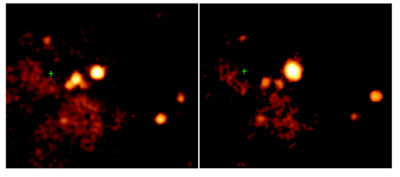[Note 09/28/00: The previously announced 600-second oscillation reported from M82 was found to be an artifact of the data screening procedure used to eliminate spurious events produced by the HRC detector electronics. This does not alter the conclusion that confirmed the existence of a mid-mass black hole 600 light years from the center of the galaxy M82. That conclusion was based on the observed intensity of the source and the accurate location for the source, which are unaffected.]
Chandra Clinches Case for Missing Link Black HoleSeptember 12, 2000
CXC PR: 00-22
The strongest evidence yet that the universe is home to a new type of black hole was reported by several groups of scientists today
Using NASA's Chandra X-ray Observatory, scientists have zeroed in on a mid-mass black hole in the galaxy M82. This black hole – located 600 light years away from the center of a galaxy – may represent the missing link between smaller stellar black holes and the supermassive variety found at the centers of galaxies.
"This opens a whole new field of research," said Martin Ward of the University of Leicester, UK, a lead author involved with the observations. "No one was sure that such black holes existed, especially outside the centers of galaxies."
The black hole in M82 packs the mass of at least 500 suns into a region about the size of the Moon. Such a black hole would require extreme conditions for its creation, such as the collapse of a "hyperstar" or the merger of scores of black holes.
The result comes as Chandra starts its second year of operation and is testimony to how Chandra's power and precision is changing the field of astronomy.
"This black hole might eventually sink to the center of the galaxy," said Dr. Hironori Matsumoto of the Massachusetts Institute of Technology, the lead author on one of three Chandra papers scheduled to be published on the mid-mass black hole, "where it could grow to become a supermassive black hole."
Although previous X-ray data from the German-U.S. Roentgen Satellite and the Japan-U.S. ASCA Satellite suggested that a mid-mass black hole might exist in M82, the crucial breakthrough came when astronomers compared the new high resolution Chandra data with optical, radio, and infrared maps of the region. They determined that most of the X-rays were coming from a single bright source.
Repeated observations of M82 over a period of eight months showed the bright X-ray source gradually peaking in X-ray brightness before dimming. Another critical discovery was that the intensity of the X rays was rising and falling every 600 seconds.
"This flickering of the X-ray intensity is similar to the well-studied characteristics of black holes swallowing gas from a nearby star or cloud. Explanations other than a massive black hole for this object are implausible," said Dr. Philip Kaaret of the Harvard-Smithsonian Center for Astrophysics, lead author on the paper reporting the 10 minute variations. "The brightness of the source requires that the black hole have a mass greater than 500 suns."
Possible explanations for the object include the merger of stars to form a hyperstar that collapsed, or growth of a black hole through mergers with other nearby black holes and neutron stars.
Observations with the Japan Nobeyama Millimeter Array by Dr. Satoki Matsushita of Harvard-Smithsonian and colleagues have revealed a large expanding superbubble of gas centered on the mid-mass black hole in M82. The energy of several thousand supernovas would be required to produce the expanding superbubble.
In the past, our Milky Way galaxy could have produced mid-mass black holes during periods of vigorous star formation. Hundreds of these massive black holes may exist unseen in our galaxy, in addition to the dozen or so known stellar black holes and the supermassive black hole that is safely confined to the galaxy's nucleus.
Other scientists involved with the Chandra observations include: Drs. A. H. Prestwich, A. Zezas, and S.S.Murray of Harvard-Smithsonian; C. Canizares of MIT; T. G. Tsuru and K. Koyama of Kyoto University, Japan; H. Awaki of Ehime University, Japan; N. Kawai of RIKEN (The Institute of Chemical & Physical Research) Japan; R. Kawabe of the Nobeyama Radio Observatory, Japan.
M82 was observed by Chandra 6 times for approximately 30 hours total. The observations were made with the High Resolution Camera (HRC) and the Advanced CCD Imaging Spectrometer (ACIS). The HRC was built for NASA by the Smithsonian Astrophysical Observatory, Cambridge, MA. The ACIS instrument was built for NASA by the Massachusetts Institute of Technology, Cambridge, and Pennsylvania State University, University Park.
NASA's Marshall Space Flight Center in Huntsville, Ala., manages the Chandra program. TRW, Inc., Redondo Beach, Calif., is the prime contractor for the spacecraft. The Smithsonian's Chandra X-ray Center controls science and flight operations from Cambridge, Mass.
Images associated with this release are available on the World Wide Web at:
High resolution digital versions of the X-ray image (JPG, 300 dpi TIFF) are available at the Internet sites listed above. This image will be available on NASA Video File which airs at noon, 3:00 p.m., 6:00 p.m., 9:00 p.m. and midnight Eastern Time. NASA Television available on GE-2, transponder 9C at 85 degrees West longitude, with vertical polarization. Frequency is on 3880.0 megahertz, with audio on 6.8 megahertz.
MEDIA CONTACTS
Dolores Beasley
Headquarters, Washington, DC
Phone: 202/358-1753
Steve Roy
Marshall Space Flight Center, Huntsville, AL
Phone: 256-544-6535
Dr. Wallace Tucker
Chandra X-ray Observatory Center, CfA, Cambridge, MA
Phone: 617-496-7998



